Investigation of Aerosol Direct Effect over China under El Niño and Its Spatial Distribution Using WRF-Chem
Abstract
1. Introduction
2. Data and Methodology
2.1. Model Settings
2.2. Datasets and Methods
3. Results
3.1. Model Evaluation
3.2. Characteristerics of the Large-Scale Circulation in Summer 2015 under El Niño
3.3. Aerosol Direct Effect Impact on Precipitation
4. Conclusions and Discussion
- As a strong El Niño event, summer 2015 showed similar signals as the mean state of El Niño years based on the composite analysis. The large-scale circulation changes of summer 2015 tended to induce cooling (warming) and wet (dry) conditions over East China (South China). Moreover, summer 2015 also showed additional features. For example, positive specific humidity anomalies were found over East China and the Pacific Ocean. This is because that the positive SST anomalies over SCS enhanced the water vapor transport eastwards. In addition, the upward motion anomalies over the West Pacific Ocean and downward motion anomalies over East China enhanced the circulation and water vapor transport from the ocean. However, the upward motion anomalies were relatively small over South China.
- Including aerosol effect and their related physical and chemical processes, the CTL test reproduced well the main characteristics of the fundamental meteorological fields based on comparing with reanalysis.
- ADE on precipitation rate showed obvious land-sea differences to those on SW. Over China, they were mainly negative, especially over SC. Aerosol scattering and absorbing effects led to decreases in SW and increases in LW, which further led to a weakened LH, a more stable atmosphere and a weakened water cycle.
- The spatial heterogeneity of ADE was discussed. The water vapor transport was suppressed due to ADE over SC (−0.151 kg m−1 s−1) while strongly enhanced over EC (0.832 kg m−1 s−1). SW reduction due to ADE was more significant over SC (16.659 W/m2) than over EC (9.312 W/m2). This implies that aerosol radiative forcing was relatively stronger over SC than over EC.
- In SC, ADE-induced precipitation reduction was mainly caused by radiative forcing and weakened water vapor transport, which enhanced atmospheric stability. The cooling effect of aerosol was consistent with the El Niño effect over SC. In EC, ADE-induced precipitation reduction was related to the vertical circulation anomalies that were contradictory with those caused by El Niño effect.
Author Contributions
Funding
Institutional Review Board Statement
Informed Consent Statement
Data Availability Statement
Acknowledgments
Conflicts of Interest
References
- Boucher, O.; Tanré, D. Estimation of the aerosol perturbation to the Earth’s Radiative Budget over oceans using POLDER satellite aerosol retrievals. Geophys. Res. Lett. 2000, 27, 1103–1106. [Google Scholar] [CrossRef]
- Carslaw, K.S.; Boucher, O.; Spracklen, D.V.; Mann, G.W.; Rae, J.G.L.; Woodward, S.; Kulmala, M. A review of natural aerosol interactions and feedbacks within the Earth system. Atmos. Chem. Phys. 2010, 10, 1701–1737. [Google Scholar] [CrossRef]
- Heald, C.L.; Ridley, D.A.; Kroll, J.H.; Barrett, S.R.H.; Cady-Pereira, K.E.; Alvarado, M.J.; Holmes, C.D. Contrasting the direct radiative effect and direct radiative forcing of aerosols. Atmos. Chem. Phys. 2014, 14, 5513–5527. [Google Scholar] [CrossRef]
- Andreae, M.O.; Rosenfeld, D. Aerosol–cloud–precipitation interactions. Part 1. The nature and sources of cloud-active aerosols. Earth-Sci. Rev. 2008, 89, 13–41. [Google Scholar] [CrossRef]
- Ghan, S.J.; Liu, X.; Easter, R.C.; Zaveri, R.; Rasch, P.J.; Yoon, J.-H.; Eaton, B. Toward a Minimal Representation of Aerosols in Climate Models: Comparative Decomposition of Aerosol Direct, Semidirect, and Indirect Radiative Forcing. J. Clim. 2012, 25, 6461–6476. [Google Scholar] [CrossRef]
- Ghan, S.J. Technical Note: Estimating aerosol effects on cloud radiative forcing. Atmos. Chem. Phys. 2013, 13, 9971–9974. [Google Scholar] [CrossRef]
- Huang, X.; Song, Y.; Zhao, C.; Cai, X.; Zhang, H.; Zhu, T. Direct Radiative Effect by Multicomponent Aerosol over China. J. Clim. 2015, 28, 3472–3495. [Google Scholar] [CrossRef]
- Li, J.; Yang, Y.; Li, F.; Lin, W. Simulated influence of air pollution and aerosols on summer precipitation over the Pearl River Delta region. Meteorol. Z. 2020, 29, 41–53. [Google Scholar] [CrossRef]
- Zhou, M.; Zhang, L.; Chen, D.; Gu, Y.; Fu, T.M.; Gao, M.; Zhao, B. The impact of aerosol-radiation interactions on the effectiveness of emission control measures. Environ. Res. Lett. 2019, 14, 024002. [Google Scholar] [CrossRef]
- Abish, B.; Mohanakumar, K. Absorbing aerosol variability over the Indian subcontinent and its increasing dependence on ENSO. Glob. Planet. Chang. 2013, 106, 13–19. [Google Scholar] [CrossRef]
- Chang, L.; Xu, J.; Tie, X.; Wu, J. Impact of the 2015 El Niño event on winter air quality in China. Sci. Rep. 2016, 6, 1–6. [Google Scholar] [CrossRef] [PubMed]
- Kim, M.; Lau, W.K.M.; Kim, K.-M.; Sang, J.; Kim, Y.H.; Lee, W.-S. Amplification of ENSO effects on Indian summer monsoon by absorbing aerosols. Clim. Dyn. 2016, 46, 2657–2671. [Google Scholar] [CrossRef]
- Bellouin, N.; Boucher, O.; Haywood, J.; Reddy, M.S. Global estimate of aerosol direct radiative forcing from satellite measurements. Nature 2005, 438, 1138–1141. [Google Scholar] [CrossRef] [PubMed]
- Grell, G.A.; Peckham, S.E.; Schmitz, R.; McKeen S., A.; Frost, G.; Skamarock, W.C.; Eder, B. Fully coupled “online” chemistry within the WRF model. Atmos. Environ. 2005, 39, 6957–6975. [Google Scholar] [CrossRef]
- Skamarock, W.C.; Klemp, J.B.; Dudhia, J.; Gill, D.O.; Barker, D.M.; Duda, M.G.; Huang, X.-Y.; Wang, W.; Powers, J.G. A description of the advanced research WRF version 3. In NCAR Technical Note; National Center for Atmospheric Research: Boulder, CO, USA, 2008. [Google Scholar]
- Hong, S.Y.; Noh, Y.; Dudhia, J. A new vertical diffusion package with an explicit treatment of entrainment processes. Monthly Weather Rev. 2006, 134, 2318–2341. [Google Scholar] [CrossRef]
- Kain, J.S.; Fritsch, J.M. Convective parameterization for mesoscale models: The Kain–Fritsch scheme. The Representation of Cumulus Convection in Numerical Models. Amer. Meteor. Soc. 1993, 165–170. [Google Scholar]
- Iacono, M.J.; Delamere, J.S.; Mlawer, E.J.; Shephard, M.W.; Clough, S.A.; Collins, W.D. Radiative forcing by long-lived greenhouse gases: Calculations with the AER radiative transfer models. J. Geophys. Res. Atmos. 2008, 113. [Google Scholar] [CrossRef]
- Stockwell, W.R.; Middleton, P.; Chang, J.S.; Tang, X. The second generation regional acid deposition model chemical mechanism for regional air quality modeling. J. Geophys. Res. Atmos. 1990, 95, 16343–16367. [Google Scholar] [CrossRef]
- Ackermann, I.J.; Hass, H.; Memmesheimer, M.; Ebel, A.; Binkowski, F.S.; Shankar, U.M.A. Modal aerosol dynamics model for Europe: Development and first applications. Atmos. Environ. 1998, 32, 2981–2999. [Google Scholar] [CrossRef]
- Schell, B.; Ackermann, I.J.; Hass, H.; Binkowski, F.S.; Ebel, A. Modeling the formation of secondary organic aerosol within a comprehensive air quality model system. J. Geophys. Res. Atmos. 2001, 106, 28275–28293. [Google Scholar] [CrossRef]
- Morrison, H.; Pinto, J.O. Mesoscale modeling of springtime Arctic mixed-phase stratiform clouds using a new two-moment bulk microphysics scheme. J. Atmos. Sci. 2005, 62, 3683–3704. [Google Scholar] [CrossRef]
- Morrison, H.; Thompson, G.; Tatarskii, V. Impact of cloud microphysics on the development of trailing stratiform precipitation in a simulated squall line: Comparison of one- and two-moment schemes. Monthly Weather Rev. 2009, 137, 991–1007. [Google Scholar] [CrossRef]
- Peckham, S.E.; Grell, G.; McKeen, S.A.; Ahmadov, R.; Fast, J.D.; Gustafson, W.I.; Ghan, S.J.; Zaveri, R.; Easter, R.C.; Barnard, J. WRF-Chem Version 3.5.1 User’s Guide; National Oceanic and Atmospheric Administration: Washington, DC, USA, 2013. [Google Scholar]
- Du, Q.; Zhao, C.; Zhang, M.; Dong, X.; Chen, Y.; Liu, Z.; Hu, Z.; Zhang, Q.; Li, Y.; Yuan, R.; et al. Modeling diurnal variation of surface PM 2.5 concentrations over East China with WRF-Chem: Impacts from boundary-layer mixing and anthropogenic emission. Atmos. Chem. Phys. 2020, 20, 2839–2863. [Google Scholar] [CrossRef]
- Guo, J.; He, J.; Liu, H.; Miao, Y.; Liu, H.; Zhai, P. Impact of various emission control schemes on air quality using WRF-Chem during APEC China 2014. Atmos. Environ. 2016, 140, 311–319. [Google Scholar] [CrossRef]
- Meng, L.; Yang, X.; Zhao, T.; He, Q.; Lu, H.; Mamtimin, A.; Huo, W.; Yang, F.; Liu, C. Modeling study on three-dimensional distribution of dust aerosols during a dust storm over the Tarim Basin, Northwest China. Atmos. Res. 2019, 218, 285–295. [Google Scholar] [CrossRef]
- Wang, P.; Qiao, X.; Zhang, H. Modeling PM2. 5 and O3 with aerosol feedbacks using WRF/Chem over the Sichuan Basin, southwestern China. Chemosphere 2020, 254, 126735. [Google Scholar] [CrossRef]
- Wei, W.; Lv, Z.F.; Li, Y.; Wang, L.T.; Cheng, S.; Liu, H. A WRF-Chem model study of the impact of VOCs emission of a huge petro-chemical industrial zone on the summertime ozone in Beijing, China. Atmos. Res. 2018, 175, 44–53. [Google Scholar] [CrossRef]
- Copernicus Climate Change Service (C3S). ERA5: Fifth generation of ECMWF atmospheric reanalyses of the global climate. Copernicus Climate Change Service Climate Data Store (CDS). 2017. Available online: https://cds.climate.copernicus.eu/cdsapp#!/home (accessed on 28 December 2020).
- Joliffe, I.T.; Stephenson, D.B. Forecast Verification: A Practitioner’s Guide in Atmospheric Science; John Wiley and Son: New York, NY, USA, 2003; p. 240. [Google Scholar]
- Wang, Y.; Qian, H.; Song, J.-J.; Jiao, M.-Y. Verification of the T213 global spectral model of China National Meteorology Center over the East-Asia area. J. Geophys. Res. 2008, 113, 1–7. [Google Scholar] [CrossRef]
- Wolter, K.; Timlin, M.S. El Niño/Southern Oscillation behaviour since 1871 as diagnosed in an extended multivariate ENSO index (MEI. ext). Int. J. Climatol. 2011, 31, 1074–1087. [Google Scholar] [CrossRef]
- Li, F.; Lin, W.; Li, J. ENSO-related impact on the vapor sources of China based on case simulations of summer 2015 and 2010. J. Atmos. Sol. Terr. Phys. 2020, 211, 105489. [Google Scholar] [CrossRef]
- De Leeuw, G.; Sogacheva, L.; Rodriguez, E.; Kourtidis, K.; Georgoulias, A.K.; Alexandri, G.; Amiridis, V.; Proestakis, E.; Marinou, E.; Xue, Y.; et al. Two decades of satellite observations of AOD over mainland China using ATSR-2, AATSR and MODIS/Terra: Data set evaluation and large-scale patterns. Atmos. Chem. Phys. 2018, 18, 1573. [Google Scholar] [CrossRef]
- Liu, Z.; Yim, S.H.; Wang, C.; Lau, N.C. The impact of the aerosol direct radiative forcing on deep convection and air quality in the Pearl River Delta region. Geophys. Res. Lett. 2018, 45, 4410–4418. [Google Scholar] [CrossRef]
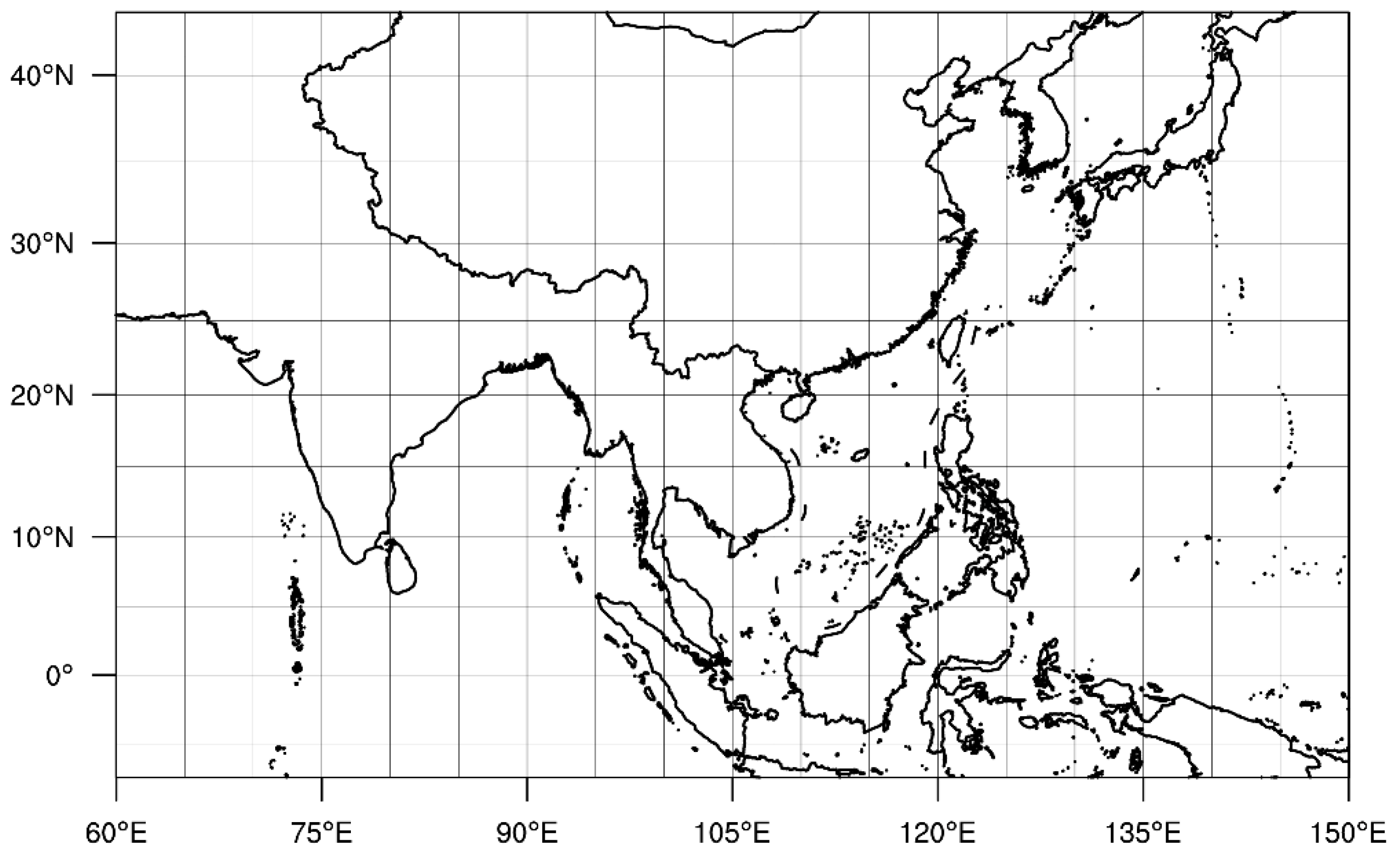
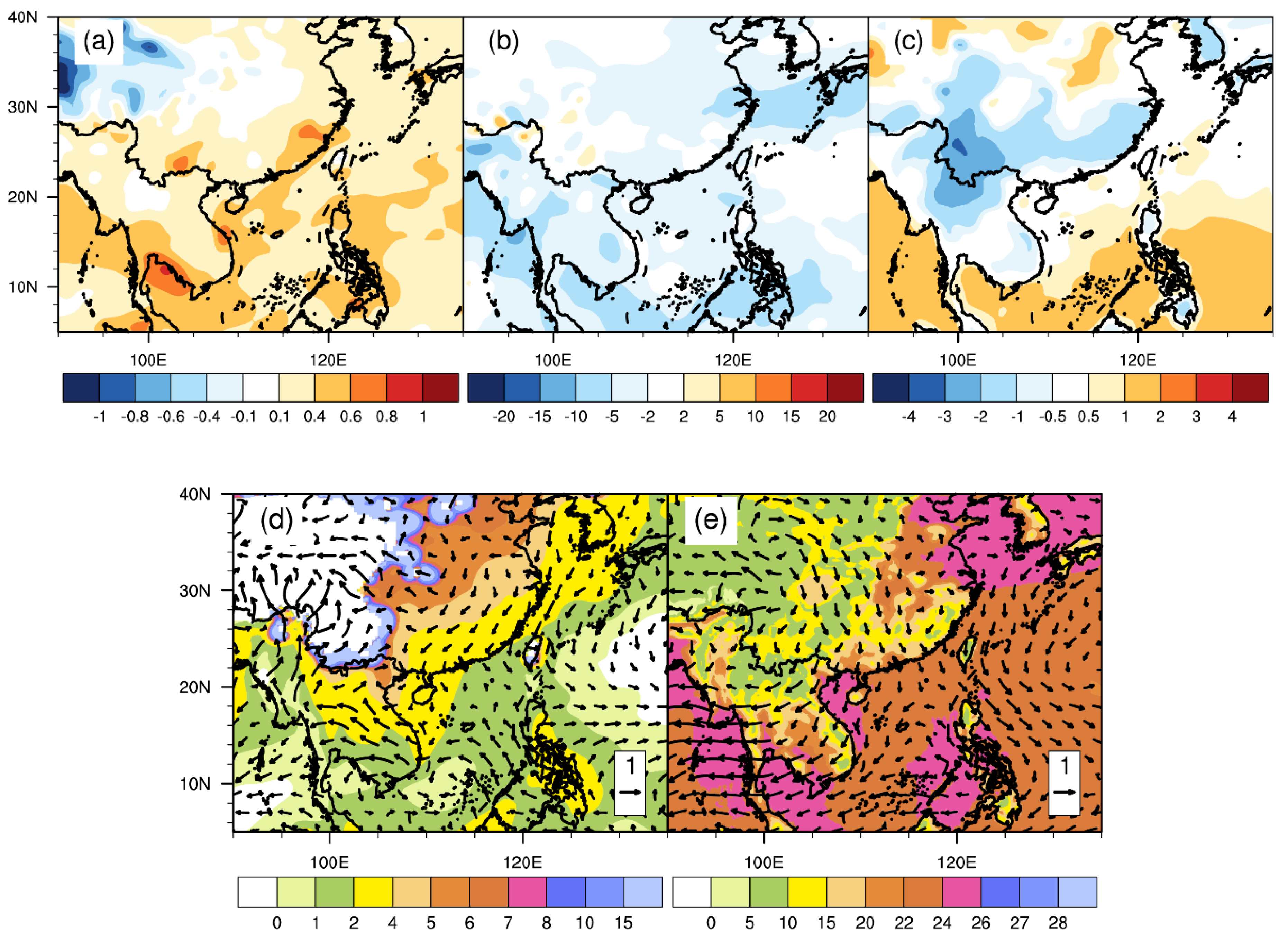
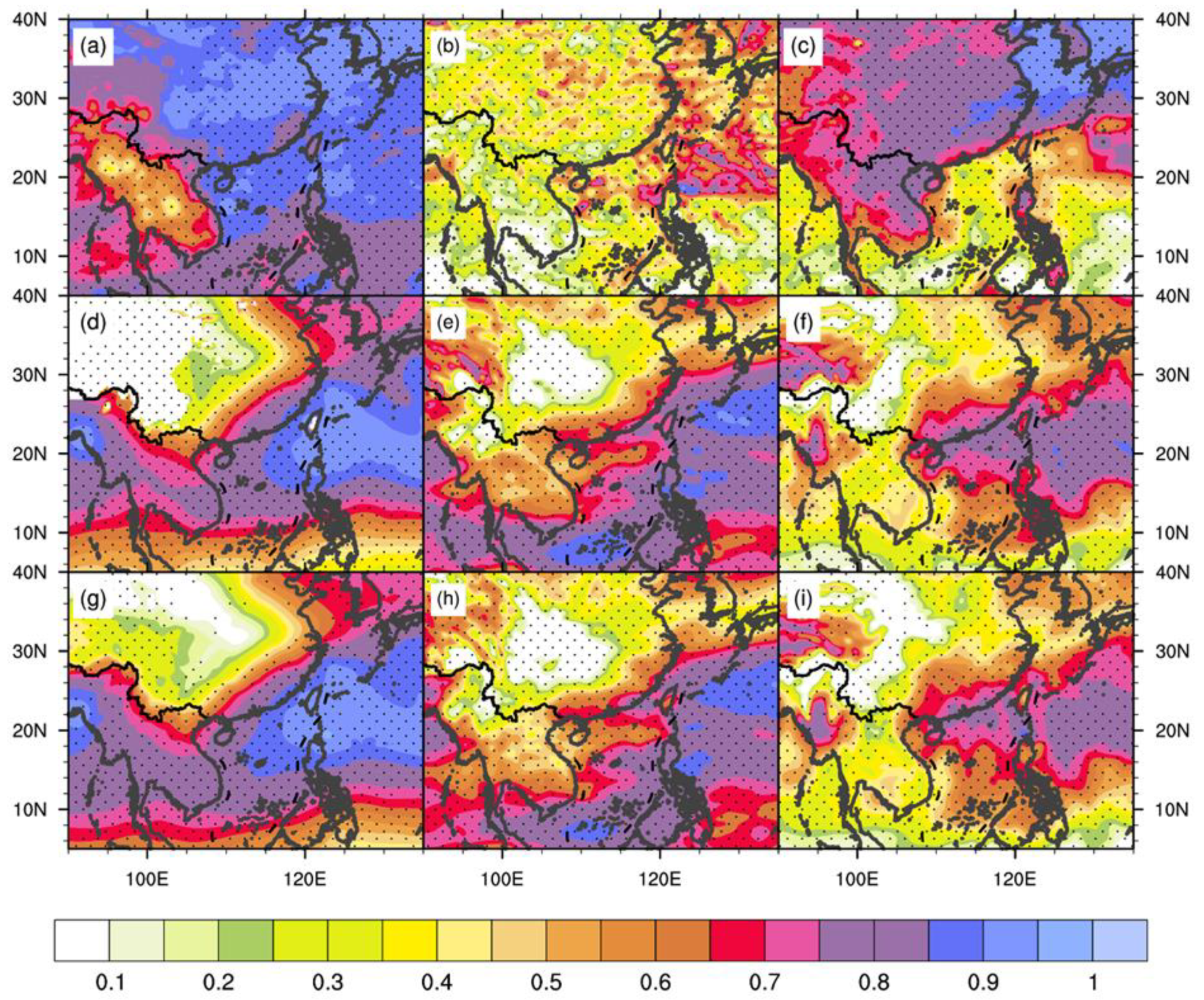
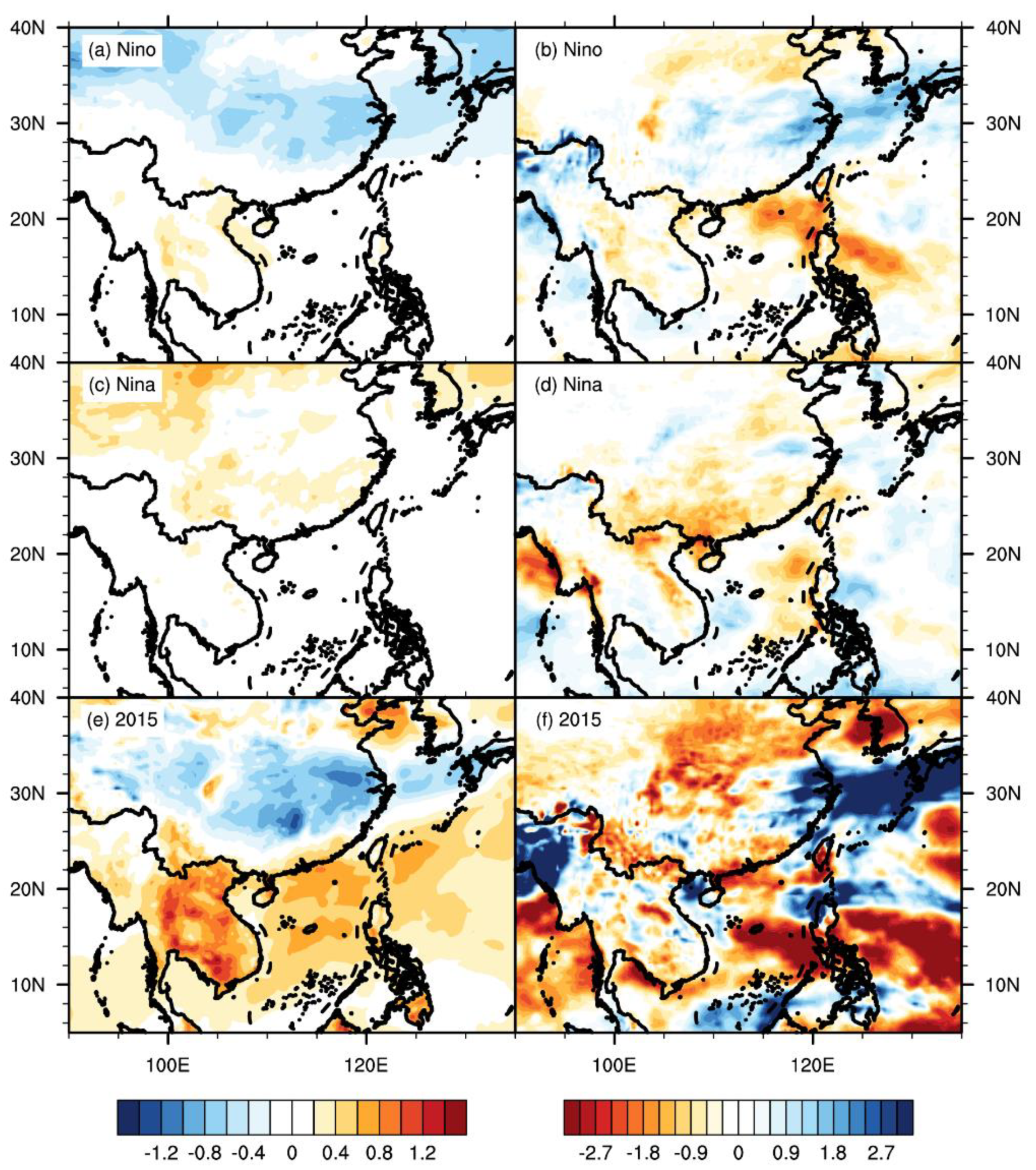
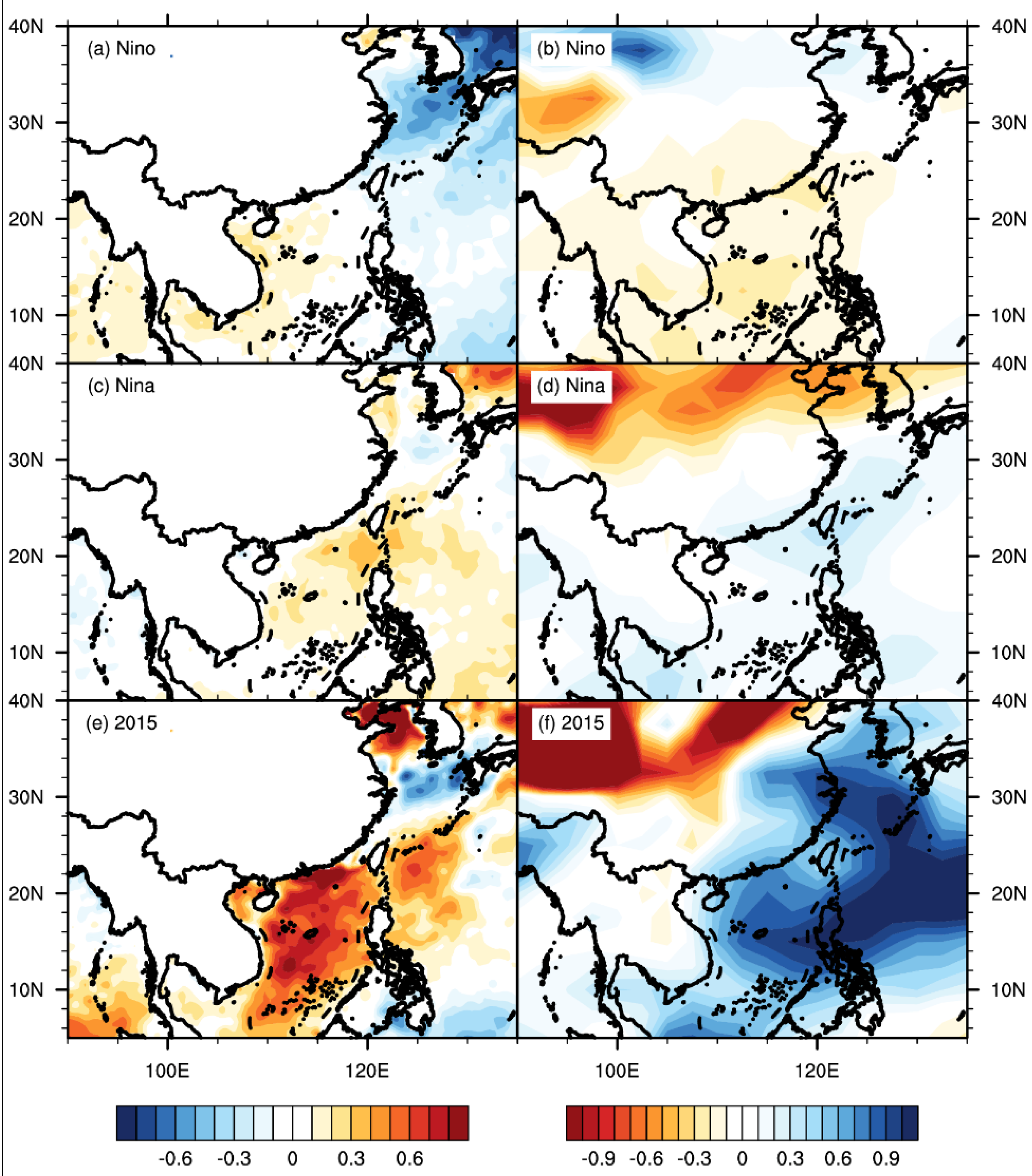
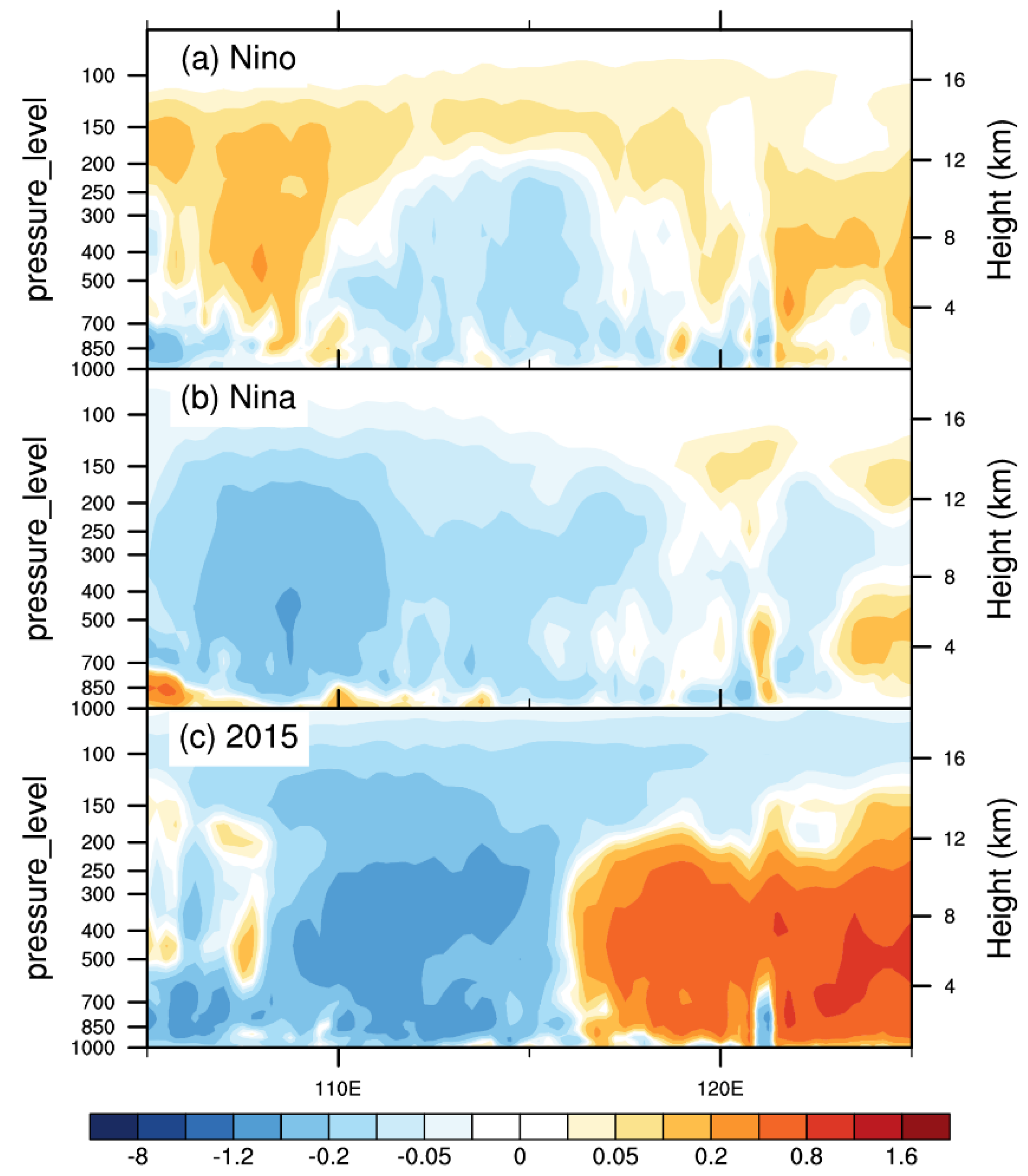
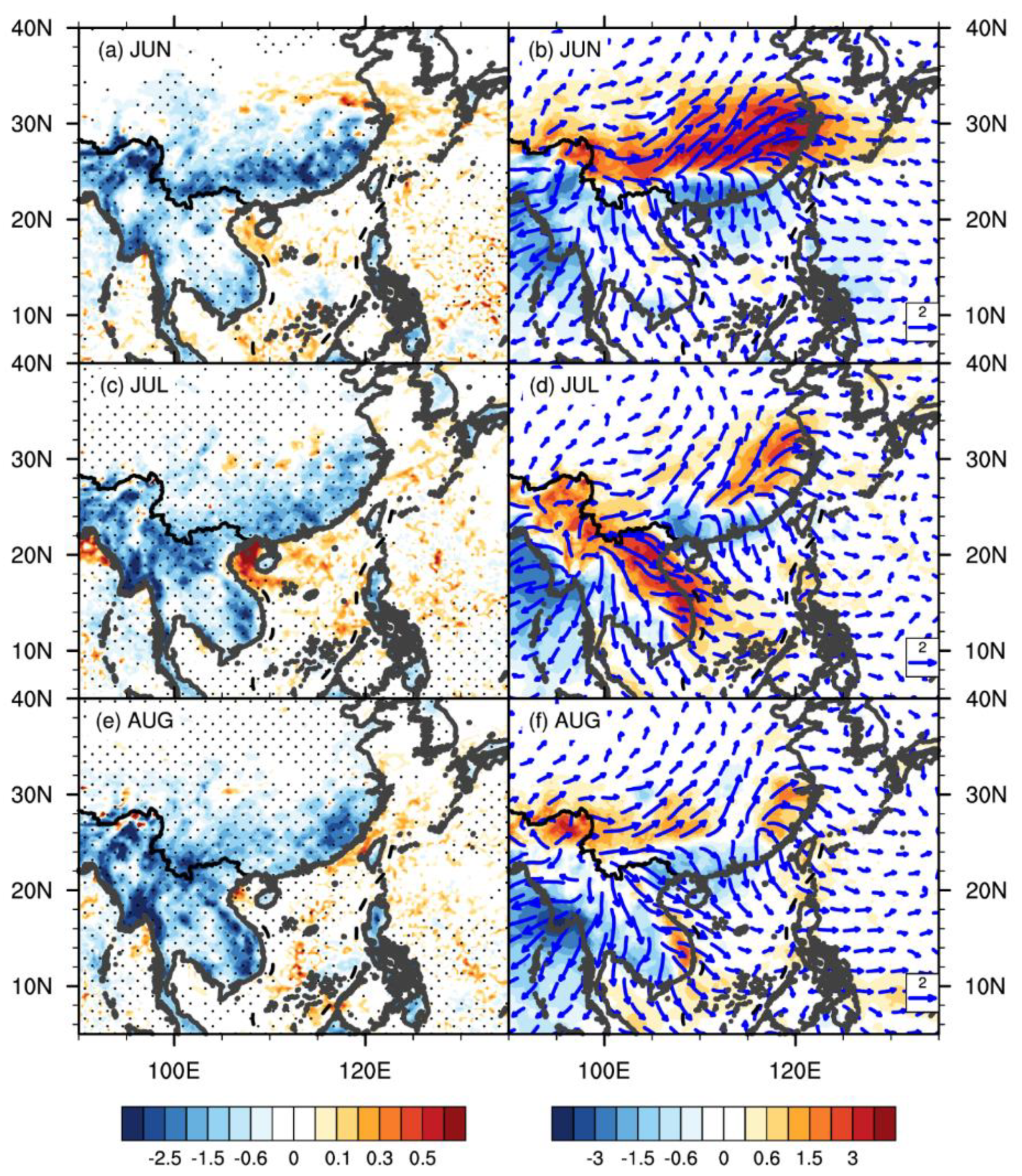
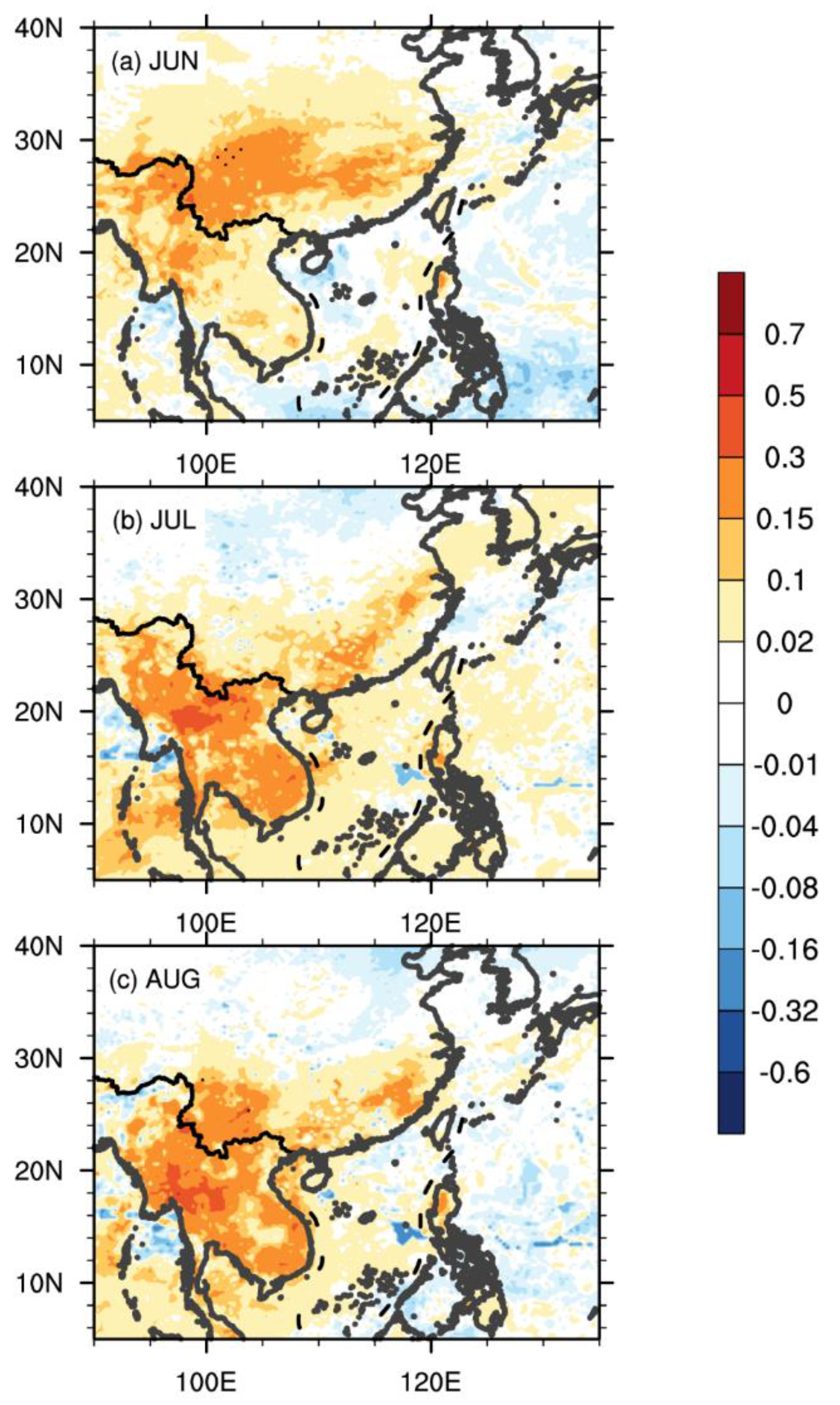
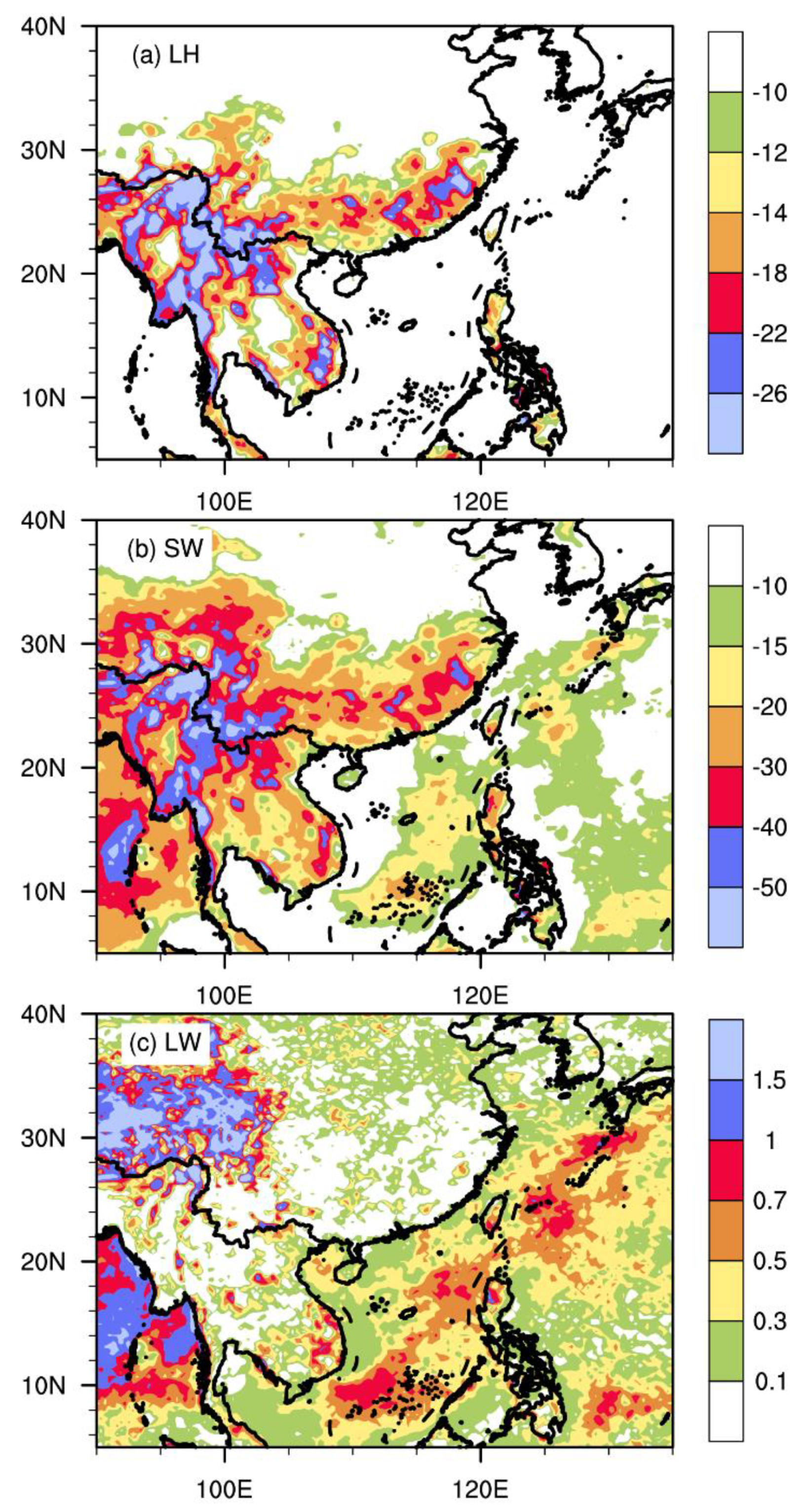
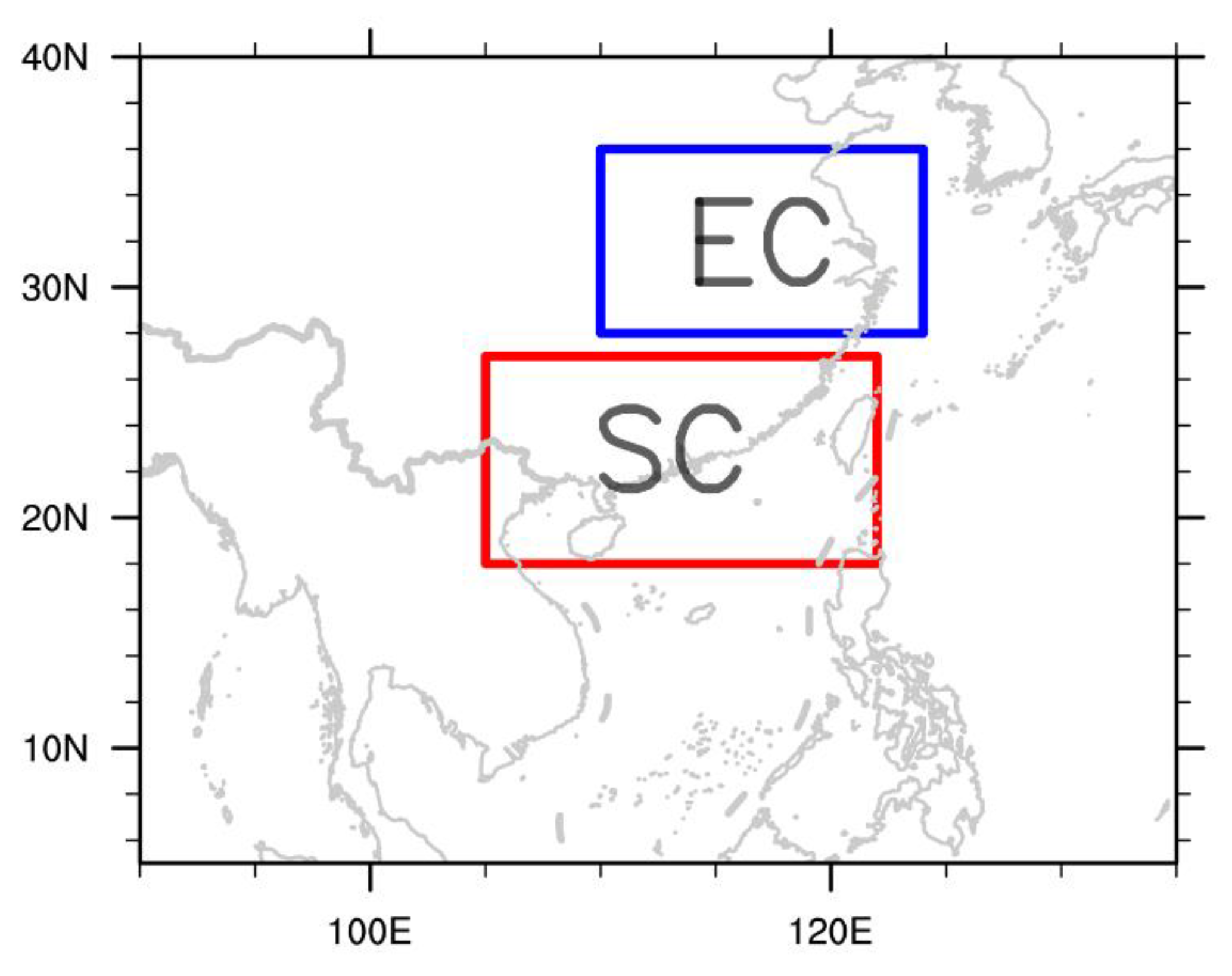
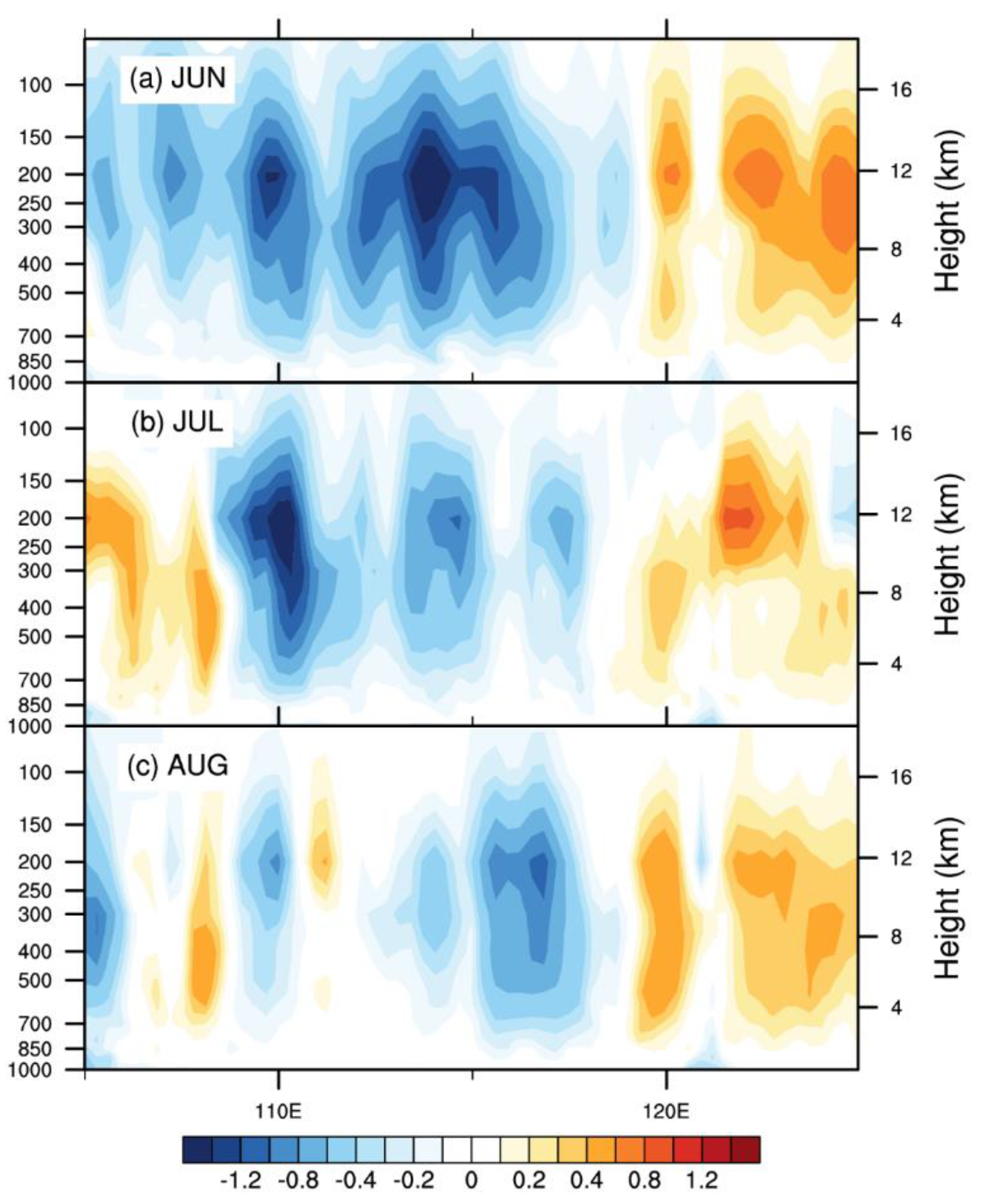
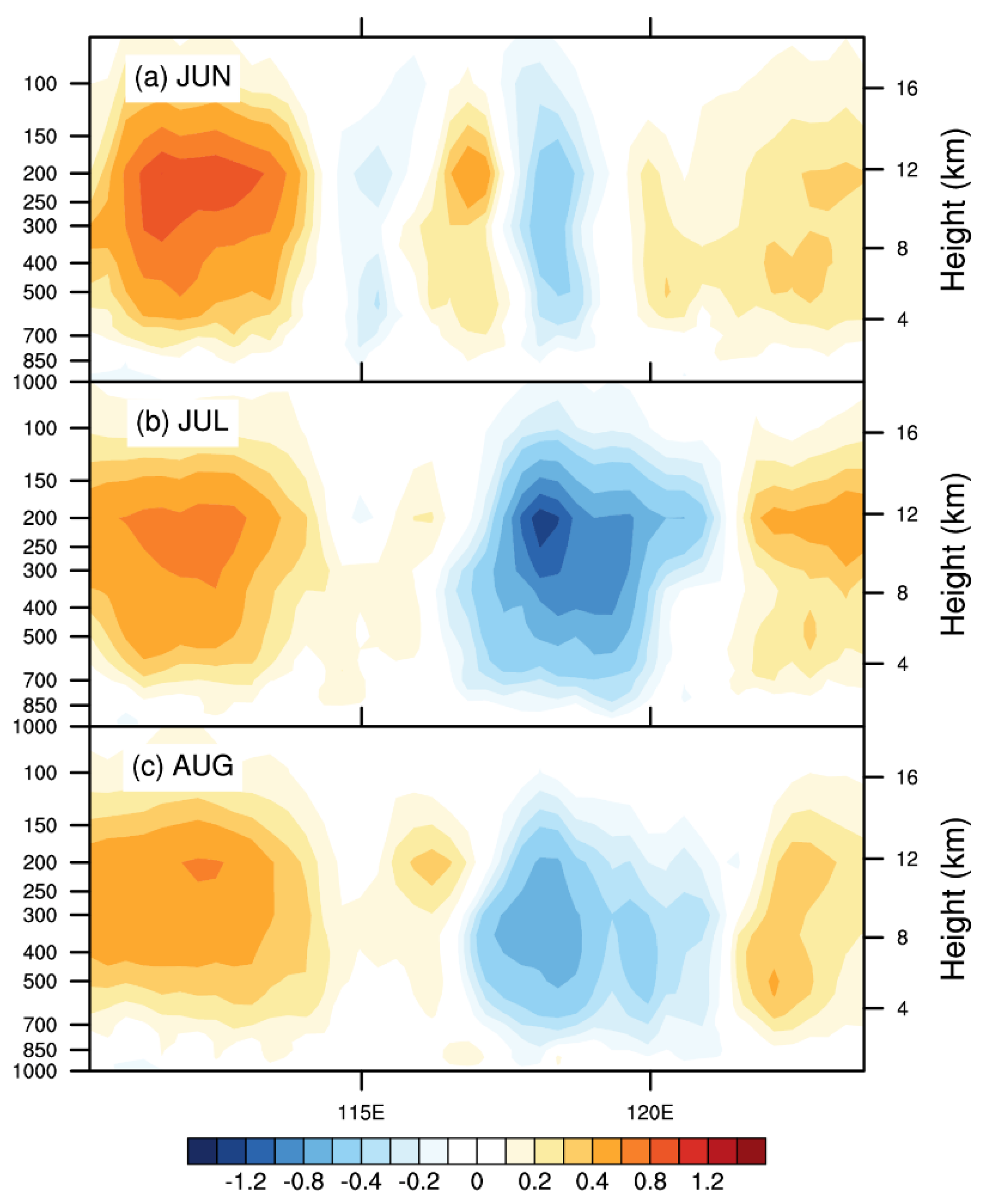
| Atmospheric Process | WRF-Chem Option |
|---|---|
| Cloud microphysics | Morrison scheme |
| Longwave and shortwave radiation | Rapid Radiative Transfer Model |
| Surface layer | Monin-Obukhov scheme |
| Land surface model | Noah Land-Surface model |
| Planetary boundary layer | YSU scheme |
| Cumulus | Kain–Fritsch scheme |
| Photolysis | Fast-J photolysis |
| Gas phase chemistry | RADM2 |
| Aerosol chemistry | MADE/SORGAM including some aqueous reactions |
| Anthropogenic emissions | RETRO |
| Test | Description | Namelist Options |
|---|---|---|
| CTL | Control experiment including aerosol effect. | aer_ra_feedback = 1 |
| SEN | Same as CTL except excluding ADE. | aer_ra_feedback = 0 |
| Variables (Unit) | Pattern Correlation 1 | NRMSE1 |
|---|---|---|
| Temperature at 2 m (K) | 0.998 | 0.0002 |
| Specific humidity (kg/kg) | 0.999 | 0.0002 |
| Precipitation rate (mm/day) | 0.792 | 0.0032 |
| Geopotential height at 850 hPa (gpm) | 0.782 | 0.00006 |
| Geopotential height at 500 hPa (gpm) | 0.987 | 0.00002 |
| U wind at 850 hPa (m/s) | 0.993 | 0.0012 |
| V wind at 850 hPa (m/s) | 0.971 | 0.0022 |
| U wind at 500 hPa (m/s) | 0.991 | 0.0012 |
| V wind at 500 hPa (m/s) | 0.962 | 0.0180 |
Publisher’s Note: MDPI stays neutral with regard to jurisdictional claims in published maps and institutional affiliations. |
© 2020 by the authors. Licensee MDPI, Basel, Switzerland. This article is an open access article distributed under the terms and conditions of the Creative Commons Attribution (CC BY) license (http://creativecommons.org/licenses/by/4.0/).
Share and Cite
Li, F.; Lin, W.; Jiang, B.; Li, J. Investigation of Aerosol Direct Effect over China under El Niño and Its Spatial Distribution Using WRF-Chem. Atmosphere 2021, 12, 58. https://doi.org/10.3390/atmos12010058
Li F, Lin W, Jiang B, Li J. Investigation of Aerosol Direct Effect over China under El Niño and Its Spatial Distribution Using WRF-Chem. Atmosphere. 2021; 12(1):58. https://doi.org/10.3390/atmos12010058
Chicago/Turabian StyleLi, Fangzhou, Wenshi Lin, Baolin Jiang, and Jiangnan Li. 2021. "Investigation of Aerosol Direct Effect over China under El Niño and Its Spatial Distribution Using WRF-Chem" Atmosphere 12, no. 1: 58. https://doi.org/10.3390/atmos12010058
APA StyleLi, F., Lin, W., Jiang, B., & Li, J. (2021). Investigation of Aerosol Direct Effect over China under El Niño and Its Spatial Distribution Using WRF-Chem. Atmosphere, 12(1), 58. https://doi.org/10.3390/atmos12010058




